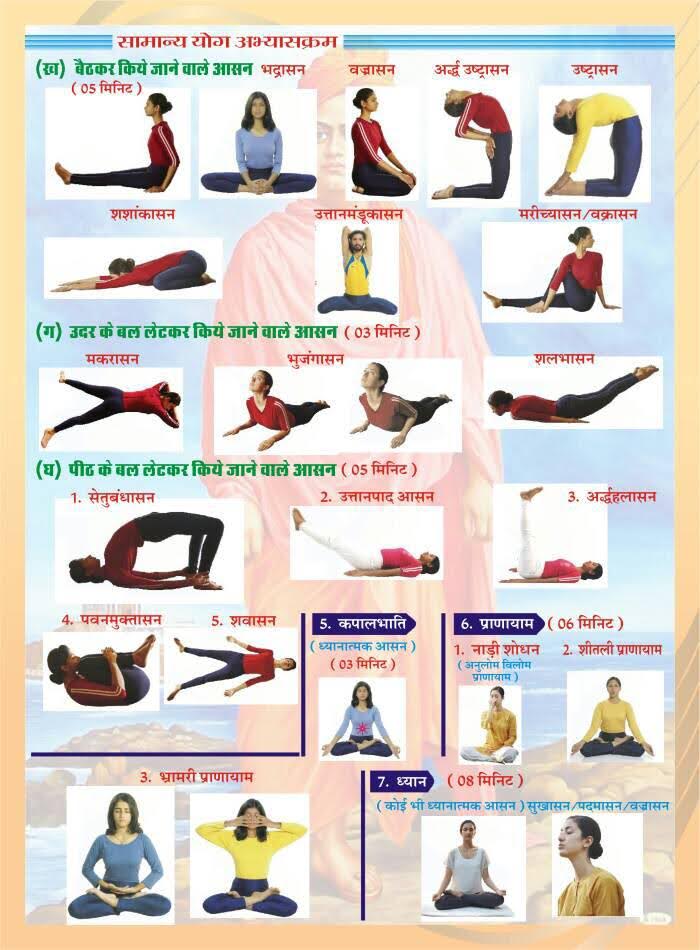|
Asanas for Internal Organs
Asanas actually boasts an impressive plethora of physical benefits and can be used as complementary therapy in combination with conventional treatments for various diseases. This article is attempted with a view to describe the asanas to tone up the internal organs and to alleviate the general ailments of the organs. For Throat region (Tonsils, thyroid glands, the pharynx, the larynx, the salivary glands as well as the auditory system) –
It is essential to practise counterpose after any inverted asana. The best counterpose is bhujangasana, ushtrasana, chakrasana, supta vajrasana and matsyasana. People suffering from excessive BP, excessive enlarged thyroid, weak heart, weak blood vessels of eyes, arteriosclerosis, cerebral thrombosis, slipped disc, during illness etc. should not do it. Sarvangasana is beneficial for operational efficiency, thyroid gland, para-thyroid gland, rejuvenate aging body, balances endocrinal system etc.
For Lungs – Makarasana (Crocodile Pose) – Lie flat on the stomach with the head and shoulders raised off the ground, head cupped in palms with elbows resting on the ground and relax the whole body. It alleviates spinal or lungs ailments. For heart – Sarpanasana (Snake Pose) - Lie flat on the floor, face downwards, extend the feet so that the heels and soles face upwards, fold the arms behind the back, inhale deeply and slowly, expanding the chest & abdomen as much as possible, at the end of inhalation slowly bend the head backwards and raise shoulders & upper back. Whole body be relaxed and tensed. Limitation – People suffering from ulcers, high BP, heart troubles or hernia should not attempt it. This asana is good for lungs, heart, back and spinal muscles. For Brain –
Practise on a blanket, mat or thin cushion. Place the blanket on the ground, kneel in the front of the blanket with the feet together or apart, interlock the fingers, place the forearms flat on the blanket in triangular form, lean forwards so that the head rests on the blanket just in the front of the clasped hands, crown should rest on the blanket, wrap the interlocked hands around the back of the head and adjust them so that they firmly support the head, straighten the legs, slowly bring the toes nearer the face, this will progressively make the back move towards the vertical position till most of the weight of the body is supported by head & arms, slowly bend the legs, bring the thighs close to the trunk without slightest tendency to topple backwards, try to raise one foot, then both feet together about 20 cms, if you feel any instability, then let the feet drop slightly onto the floor, repeat the process & perfect the process of raising the feet off the ground without losing balance, slowly raise the legs upwards & knees pointing downwards, keeping the heels near the buttocks, maintain the equilibrium, slowly raise the knees upwards & finally pointing directly upwards, make sure spine & thighs in line – straight & vertical, slowly raise the feet so that they point upwards, whole body in one line, breathe slowly & deeply, return to the starting pose. Beginners can start it with 30 seconds. It can be done for a few minutes. Counterpose of Sirasana is Tadasana. People suffering from High BP, weak heart, cerebral or coronary thrombosis, weak eye-blood vessels, conjunctivitis & chronic glaucoma, haemorrhage, inflammation in ears, chronic catarrh, sliiped disc, extremely impure blood, kidney problems etc. should not practice Sirshasana.
For Chest – Shallow breathing is often caused by inflexibility of the ribcage. Ushtrasana (Camel pose, backward bending asana) – knees and feet are separated by the same width as the hips. The top of the feet should rest on the ground. Thigh, trunk and head should be vertical. Then lean backward slightly and grasp the right heel with the right hand. Allow the arms to support the weight of the body. Tilt the head backwards as far as it is comfortable. Relax the muscles of the neck, legs, arms and back as much as possible. Breathe normally. Then return to the starting position by tensing all the muscles. For Reproductive System – Shashank Bhujangasana (Striking Cobra Pose) – It combines the backward bending (Bhujangasana) and forward bending. In forward bending, arms are outstretched in front of the shoulder and body weight is gradually transferred on the palms. It gives similar benefits as Bhujangasana and shashankasana. It is particularly useful in toning reproductive organs. For abdominal organs (liver, pancreas, alimentary canal, kidneys and spinal column) – To alleviates abdominal disorders such as constipation, indigestion etc.
Reference: A systematic Course in the Ancient Tantric Techniques of Yoga and Kriya – by Swami Satyananda Saraswati
0 Comments
Leave a Reply. |
Archives
July 2024
Categories |

 RSS Feed
RSS Feed